Chapter 25: Physical Development in Middle Adulthood
Chapter 25 Learning Objectives
- Explain the difference between primary and secondary aging
- Describe sensory changes that occur during middle adulthood
- Identify health concerns in middle adulthood
- Explain what occurs during the climacteric for females and males
- Describe sexuality during middle adulthood
- Explain the importance of sleep and consequences of sleep deprivation
- Describe the importance of exercise and nutrition for optimal health
- Describe brain functioning in middle adulthood
Each person experiences age-related physical changes based on many factors: biological factors, such as molecular and cellular changes, and oxidative damage are called primary aging, while aging that occurs due to controllable factors, such as an unhealthy lifestyle including lack of physical exercise and poor diet, is called secondary aging (Busse, 1969). These factors are shown in Figure 8.1
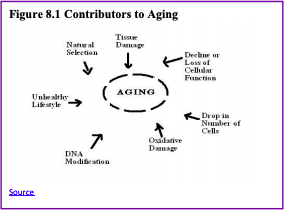
Getting out of shape is not an inevitable part of aging; it is probably due to the fact that middle- aged adults become less physically active and have experienced greater stress. Smoking tobacco, drinking alcohol, poor diet, stress, physical inactivity, and chronic disease, such as diabetes or arthritis, reduce overall health. However, there are things can be done to combat many of these changes by adopting healthier lifestyles.
Physical Changes
Hair: When asked to imagine someone in middle adulthood, we often picture someone with the beginnings of wrinkles and gray or thinning hair. What accounts for these physical changes?
Hair color is due to a pigment called melanin which is produced by hair follicles (Martin, 2014). With aging, the hair follicles produce less melanin, and this causes the hair to become gray. Hair color typically starts turning lighter at the temples, but eventually all the hair will become white. For many, graying begins in the 30s, but it is largely determined by your genes. Gray hair occurs earlier in white people and later in Asians.
Genes also determine how much hair remains on your head. Almost everyone has some hair loss with aging, and the rate of hair growth slows with aging. Many hair follicles stop producing new hairs and hair strands become smaller. Men begin showing signs of balding by 30 and some are nearly bald by 60. Male-pattern baldness is related to testosterone and is identified by a receding hairline followed by hair loss at the top of the head. Figure 8.2 shows tennis champion Andre Agassi’s characteristic male- patterned baldness. Women can also develop female- patterned baldness as their hair becomes less dense and the scalp becomes visible (Martin, 2014). Sudden hair loss, however, can be a symptom of a health problem.

Skin: Skin continues to dry out and is prone to more wrinkling, particularly on the sensitive face area. Wrinkles, or creases in the skin, are a normal part of aging. As we get older, our skin dries and loses the underlying layer of fat, so our face no longer appears smooth. Loss of muscle tone and thinning skin can make the face appear flabby or drooping. Although wrinkles are a natural part of aging and genetics plays a role, frequent sun exposure and smoking will cause wrinkles to appear sooner. Dark spots and blotchy skin also occur as one ages and are due to exposure to sunlight (Moskowitz, 2014). Blood vessels become more apparent as the skin continues to dry and get thinner.
Sarcopenia: The loss of muscle mass and strength that occurs with aging is referred to as sarcopenia (Morley, Baumgartner, Roubenoff, Mayer, & Nair, 2001). Sarcopenia is thought to be a significant factor in the frailty and functional impairment that occurs when older. The decline of growth and anabolic hormones, especially testosterone, and decreased physical activity have been implicated as causes of sarcopenia (Proctor, Balagopal, & Nair, 1998). This decline in muscle mass can occur as early as 40 years of age and contributes significantly to a decrease in life quality, increase in health care costs, and early death in older adults (Karakelides & Nair, 2005). Exercise is certainly important to increase strength, aerobic capacity, and muscle protein synthesis, but unfortunately it does not reverse all the age-related changes that occur. The muscle-to-fat ratio for both men and women also changes throughout middle adulthood, with an accumulation of fat in the stomach area.
Lungs: The lungs serve two functions: Supply oxygen and remove carbon dioxide. Thinning of the bones with age can change the shape of the rib cage and result in a loss of lung expansion. Age-related changes in muscles, such as the weakening of the diaphragm, can also reduce lung capacity. Both of these changes will lower oxygen levels in the blood and increase the levels of carbon dioxide. Experiencing shortness of breath and feeling tired can result (NIH, 2014b). In middle adulthood, these changes and their effects are often minimal, especially in people who are non-smokers and physically active. However, in those with chronic bronchitis, or who have experienced frequent pneumonia, asthma other lung-related disorders, or who are smokers, the effects of these normal age changes can be more pronounced.
Sensory Changes
Vision: A normal change of the eye due to age is presbyopia, which is Latin for “old vision.” It refers to a loss of elasticity in the lens of the eye that makes it harder for the eye to focus on objects that are closer to the person. When we look at something far away, the lens flattens out; when looking at nearby objects tiny muscle fibers around the lens enable the eye to bend the lens. With age these muscles weaken and can no longer accommodate the lens to focus the light. Anyone over the age of 35 is at risk for developing presbyopia. According to the National Eye Institute (NEI) (2016), signs that someone may have presbyopia include:
- Hard time reading small print
- Having to hold reading material farther than arm’s distance
- Problems seeing objects that are close
- Headaches
- Eyestrain
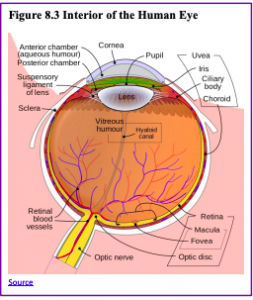
Another common eye problem people experience as they age are floaters, little spots or “cobwebs” that float around the field of vision. They are most noticeable if you are looking at the sky on a sunny day, or at a lighted blank screen. Floaters occur when the vitreous, a gel-like substance in the interior of the eye, slowly shrinks. As it shrinks, it becomes somewhat stringy, and these strands can cast tiny shadows on the retina. In most cases, floaters are harmless, more of an annoyance than a sign of eye problems. However, floaters that appear suddenly, or that darken and obscure vision can be a sign of more serious eye problems, such a retinal tearing, infection, or inflammation. People who are very nearsighted (myopic), have diabetes, or who have had cataract surgery are also more likely to have floaters (NEI, 2009).
During midlife, adults may begin to notice a drop in scotopic sensitivity, the ability to see in dimmer light. By age 60, the retina receives only one third as much light as it did at age 20, making working in dimmer light more difficult (Jackson & Owsley, 2000). Night vision is also affected as the pupil loses some of its ability to open and close to accommodate drastic changes in light. Eyes become more sensitive to glare from headlights and street lights making it difficult to see people and cars, and movements outside of our direct line of sight (NIH, 2016c).
Finally, some people experience dry eye syndrome, which occurs when the eye does not produce tears properly, or when the tears evaporate too quickly because they are not the correct consistency (NEI, 2013). While dry eye can affect people at any age, nearly 5 million Americans over the age of 50 experience dry eye. It affects women more than men, especially after menopause. Women who experienced an early menopause may be more likely to experience dry eye, which can cause surface damage to the eye.
Hearing: Hearing problems increase during middle adulthood. According to a recent UK study (Dawes et al., 2014), the rate of hearing problems in their sample doubled between the ages of 40 and 55 and tripled by age 64. Similar statistics are found in U.S. samples of middle-aged adults. Prior to age 40, about 5.5% of adults report hearing problems. This jumps to 19% among 40 to 69 year-olds (American Psychological Association, 2016). Middle-aged adults may experience more problems understanding speech when in noisy environments, in comparison to younger adults (Füllgrabe, Moore, & Stone, 2015; Neidleman, Wambacq, Besing, Spitzer, & Koehnke, 2015). As we age we also lose the ability to hear higher frequencies (Humes, Kewley-Port, Fogerty, & Kinney, 2010). Hearing changes are more common among men than women, but males may underestimate their hearing problems (Uchida, Nakashima, Ando, Niino, & Shimokata, 2003). For many adults, hearing loss accumulates after years of being exposed to intense noise levels. Men are more likely to work in noisy occupations. Hearing loss is also exacerbated by cigarette smoking, high blood pressure, diabetes, and stroke. Most hearing loss could be prevented by guarding against being exposed to extremely noisy environments.
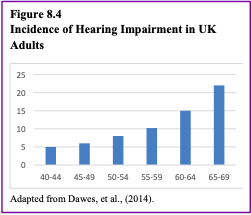
Health Concerns
Heart Disease: According to the most recent National Vital Statistics Reports (Kochanek, Murphy, Xu, & Arias, 2019) heart disease continues to be the number one cause of death for Americans as it claimed 23% of those who died in 2017. It is also the number one cause of death worldwide (World Health Organization, 2018). Heart disease develops slowly over time and typically appears in midlife (Hooker & Pressman, 2016).
Heart disease can include heart defects and heart rhythm problems, as well as narrowed, blocked, or stiffened blood vessels referred to as cardiovascular disease. The blocked blood vessels prevent the body and heart from receiving adequate blood. Atherosclerosis, or a buildup of fatty plaque in the arteries, is the most common cause of cardiovascular disease. The plaque buildup thickens the artery walls and restricts the blood flow to organs and tissues. Cardiovascular disease can lead to a heart attack, chest pain (angina), or stroke (Mayo Clinic, 2014a). Figure 8.5 illustrates atherosclerosis.
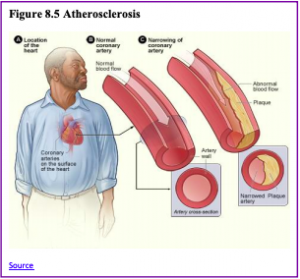
Symptoms of cardiovascular disease differ for men and women. Males are more likely to suffer chest pain, while women are more likely to demonstrate shortness of breath, nausea, and extreme fatigue. Symptoms can also include pain in the arms, legs, neck, jaw, throat, abdomen or back (Mayo Clinic, 2014a). According to the Mayo Clinic (2014a) there are many risk factors for developing heart disease, including medical conditions, such as high blood pressure, high cholesterol, diabetes, and obesity. Other risk factors include:
- Advanced Age-increased risk for narrowed arteries and weakened or thickened heart muscle.
- Sex-males are at greater risk, but a female’s risk increases after menopause.
- Family History-increased risk, especially if male parent or brother developed heart. disease before age 55 or female parent or sister developed heart disease before age 65.
- Smoking-nicotine constricts blood vessels and carbon monoxide damages the inner lining.
- Poor Diet-a diet high in fat, salt, sugar, and cholesterol.
- Excessive Alcohol Consumption-alcohol can raise the level of bad fats in the blood and increase blood pressure
- Stress-unrelieved stress can damage arteries and worsen other risk factors.
- Poor Hygiene-establishing good hygiene habits can prevent viral or bacterial infections that can affect the heart. Poor dental care can also contribute to heart disease.
Complications of heart disease can include heart failure, when the heart cannot pump enough blood to the meet the body’s needs, and a heart attack, such as when a blood clot blocks the blood flow to the heart. This blockage can damage or destroy a part of the heart muscle, and atherosclerosis is a factor in a heart attack. Treatment for heart disease includes medication, surgery, and lifestyle changes including exercise, healthy diet, and refraining from smoking.
Sudden cardiac arrest is the unexpected loss of heart functioning, breathing, and consciousness, often caused by an arrhythmia or abnormal heartbeat. The heartbeat may be too quick, too slow, or irregular. With a healthy heart, it is unlikely for a fatal arrhythmia to develop without an outside factor, such as an electric shock or illegal drugs. If not treated immediately, sudden cardiac arrest can be fatal and result in sudden cardiac death.
Hypertension, or high blood pressure, is a serious health problem that occurs when the blood flows with a greater force than normal. One in three American adults (70 million people) have hypertension and only half have it under control (Nwankwo, Yoon, Burt, & Gu, 2013). It can strain the heart, increase the risk of heart attack and stroke, or damage the kidneys (CDC, 2014a). Uncontrolled high blood pressure in early and middle adulthood can also damage the brain’s white matter (axons) and may be linked to cognitive problems later in life (Maillard et al., 2012). Normal blood pressure is under 120/80 (see Table 8.1). The first number is the systolic pressure, which is the pressure in the blood vessels when the heartbeats. The second number is the diastolic pressure, which is the pressure in the blood vessels when the heart is at rest. High blood pressure is sometimes referred to as the silent killer, as most people with hypertension experience no symptoms. Making positive lifestyle changes can often reduce blood pressure.

Risk factors for high blood pressure include:
- Family history of hypertension
- A diet that is too high in sodium often found in processed foods, and too low in potassium
- Sedentary lifestyle and Obesity
- Too much alcohol consumption
- Tobacco use, as nicotine raises blood pressure (CDC, 2014b)
Cancer: After heart disease, cancer was the second leading cause of death for Americans in 2017 as it accounted for 21.3% of all deaths (Kochanek et al., 2016). According to the National Institutes of Health (2015), cancer is the name given to a collection of related diseases in which the body’s cells begin to divide without stopping and spread into surrounding tissues. These extra cells can divide, and form growths called tumors, which are typically masses of tissue. Cancerous tumors are malignant, which means they can invade nearby tissues. When removed malignant tumors may grow back. Unlike malignant tumors, benign tumors do not invade nearby tissues. Benign tumors can sometimes be quite large, and when removed usually do not grow back. Although benign tumors in the body are not cancerous, benign brain tumors can be life-threatening.
Cancer cells can prompt nearby normal cells to form blood vessels that supply the tumors with oxygen and nutrients, which allows them to grow. These blood vessels also remove waste products from the tumors. Cancer cells can also hide from the immune system, a network of organs, tissues, and specialized cells that protects the body from infections and other conditions. Lastly, cancer cells can metastasize, which means they can break from where they first formed, called the primary cancer, and travel through the lymph system or blood to form new tumors in other parts of the body. This new metastatic tumor is the same type as the primary tumor (National Institutes of Health, 2015). Figure 8.6 illustrates how cancers can metastasize.
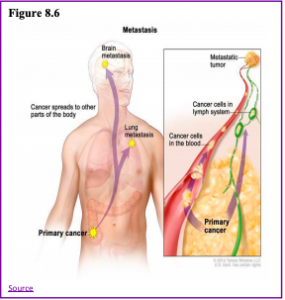
Cancer can start almost anywhere in the human body. While normal cells mature into very distinct cell types with specific functions, cancer cells do not and continue to divide without stopping. Further, cancer cells are able to ignore the signals that normally tell cells to stop dividing or to begin a process known as programmed cell death which the body uses to get rid of unneeded cells. With the growth of cancer cells, normal cells are crowded out and the body is unable to work the way it is supposed to. For example, the cancer cells in lung cancer form tumors which interfere with the functioning of the lungs and how oxygen is transported to the rest of the body.
There are more than 100 types of cancer. The American Cancer Society assembles a list of the most common types of cancers in the United States. To qualify for the 2016 list, the estimated annual incidence had to be 40, 000 cases or more. The most common type of cancer on the list is breast cancer, with more than 249,000 new cases expected in 2016. The next most common cancers are lung cancer and prostate cancer. Table 8.2 lists the estimated number of new cases and deaths for each common cancer type for 2019 (American Cancer Society, 2019).
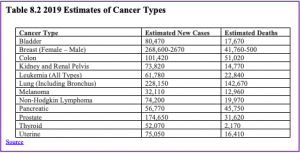
Cholesterol is a waxy fatty substance carried by lipoprotein molecules in the blood. It is created by the body to create hormones and digest fatty foods and is also found in many foods. Your body needs cholesterol, but too much can cause heart disease and stroke. Two important kinds of cholesterol are low-density lipoprotein (LDL) and high-density lipoprotein (HDL). The third type of fat is called triglycerides. Your total cholesterol score is based on all three types of lipids (see Table 8.3). Total cholesterol is calculated by adding HDL plus LDL plus 20% of the Triglycerides.
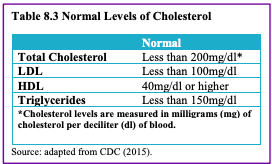
LDL cholesterol makes up the majority of the body’s cholesterol, however, it is often referred to as “bad” cholesterol because at high levels it can form plaque in the arteries leading to heart attack and stroke. HDL cholesterol often referred to as “good” cholesterol, absorbs cholesterol and carries it back to the liver, where it is then flushed from the body. Higher levels of HDL can reduce the risk of heart attack and stroke. Triglycerides are a type of fat in the blood used for energy. High levels of triglycerides can also increase your risk for heart disease and stroke when coupled with high LDL and low HDL. All adults 20 or older should have their cholesterol checked. In early adulthood, doctors may check every few years if the numbers have previously been normal, and there are no other signs of heart disease. In middle adulthood, this may become part of the annual check-up (CDC, 2015).
Risk factors for high cholesterol include: A family history for high cholesterol, diabetes, a diet high in saturated fats, trans fat, and cholesterol, physical inactivity, and obesity. Almost 32% of American adults have high LDL cholesterol levels, and the majority do not have it under control, nor have they made lifestyle changes (CDC, 2015).
Diabetes (Diabetes Mellitus) is a disease in which the body does not control the amount of glucose in the blood. This disease occurs when the body does not make enough insulin or does not use it the way it should (NIH, 2016a). Insulin is a type of hormone that helps glucose in the blood enter cells to give them energy. In adults, 90% to 95% of all diagnosed cases of diabetes are type 2 (American Diabetes Association (ADA), 2016). Type 2 diabetes usually begins with insulin resistance, a disorder in which the cells in the muscles, liver, and fat tissue do not use insulin properly (CDC, 2014d). As the need for insulin increases, cells in the pancreas gradually lose the ability to produce enough insulin. In some Type 2 diabetics, pancreatic beta cells will cease functioning, and the need for insulin injections will become necessary. Some people with diabetes experience insulin resistance with only minor dysfunction of the beta-cell secretion of insulin. Other diabetics experience only slight insulin resistance, with the primary cause being a lack of insulin secretion (CDC, 2014d).
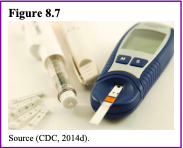
One in three adults are estimated to have prediabetes, and 9 in 10 of them do not know. According to the CDC (2014d) without intervention, 15% to 30% of those with prediabetes will develop diabetes within 5 years. In 2015, 30.2 million people (9.4% of the population) were living with diabetes in America, mostly adults age 18 and up (CDC, 2017). Table 8.4 shows the numbers in millions and percentage of adults, by age and gender, with both diagnosed and undiagnosed diabetes. The median age of diagnosis is 54 (CDC, 2014d). During middle adulthood, the number of people with diabetes dramatically increases; with 4.3 million living with diabetes prior to age 45, to over 13 million between the ages of 45 to 64; a four-fold increase. Men are slightly more likely to experience diabetes than are women.
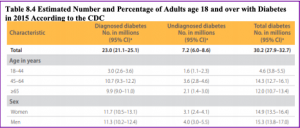
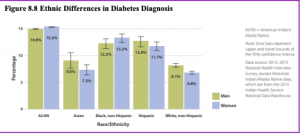
Diabetes also affects ethnic and racial groups differently. Non-Hispanic Whites are less likely to be diagnosed with diabetes than are Asian Americans, Hispanics, non-Hispanic Blacks, and American Indians/Alaskan Natives. However, these general figures hide the variations within these groups. For instance, the rate of diabetes was less for Central, South, and Cuban Americans than for Mexican Americans and Puerto Ricans, and less for Alaskan Natives than the American Indians of southern Arizona (CDC, 2017). Additionally, educational attainment, which is linked to one’s economic level, is correlated with diabetes. Percentages includes: Less than a high school degree (21.6%), high school degree (9.5%), and more than a high school degree (7.2%).
The risk factors for diabetes include:
- Those over age 45
- Obesity
- Family history of diabetes
- History of gestational diabetes (see Chapter 2)
- Race and ethnicity
- Physical inactivity
- Diet.
Diabetes has been linked to numerous health complications. Adults with diabetes are 1.7 times more likely to have cardiovascular disease, 1.8 times more likely to experience a heart attack, and 1.5 times more likely to experience stroke than adults without diabetes. Diabetes can cause blindness and other eye problems. Between 40%-45% of Americans with diabetes have some degree of diabetic retinopathy, which is damage to the small blood vessels in the retina that may lead to loss of vision (NEI, 2015). More than 4% showed advanced diabetic retinopathy. Diabetes is linked as the primary cause of almost half (44%) of new cases of kidney failure each year. About 60% of non-traumatic limb amputations occur in people with diabetes. Diabetes has been linked to hearing loss, tinnitus (ringing in the ears), gum disease, and neuropathy (nerve disease) (CDC, 2014d).
Typical tests for diabetes include a fasting glucose test and the A1C (See Table 8.5). Fasting glucose levels should be under 100mg/dl (ADA, 2016). The A1C provides information about the average levels of blood glucose over the last 3 months (NIH, 2014a). The A1C should be under 5.7, where a 5.0 = 97mg/dl and a 6.0 = 126 mg/dl (ADA, 2016).

Metabolic Syndrome is a cluster of several cardiometabolic risk factors, including large waist circumference, high blood pressure, and elevated triglycerides, LDL, and blood glucose levels, which can lead to diabetes and heart disease (Crist et al., 2012). The prevalence of metabolic syndrome in the U.S. is approximately 34% and is especially high among Hispanics and African Americans (Ford, Li, & Zhao, 2010). Prevalence increases with age, peaking in one’s 60s (Ford et al., 2010). Metabolic syndrome increases morbidity from cardiovascular disease and diabetes (Hu et al., 2004; Malik, 2004). Hu and colleagues found that even having one or two of the risk factors for metabolic syndrome increased the risk of mortality. Crist et al. (2012) found that increasing aerobic activity and reducing weight led to a drop in many of the risk factors of metabolic syndrome, including a reduction in waist circumference and blood pressure, and an increase in HDL cholesterol.
Rheumatoid arthritis (RA) is an inflammatory disease that causes pain, swelling, stiffness, and loss of function in the joints (NIH, 2016b). RA occurs when the immune system attacks the membrane lining the joints (see Figure 8.8). RA is the second most common form of arthritis after osteoarthritis, which is the normal wear and tear on the joints discussed in chapter 9. Unlike osteoarthritis, RA is symmetric in its attack of the body, thus, if one shoulder is affected so is the other. In addition, those with RA may experience fatigue and fever. Below are the common features of RA (NIH, 2016b).
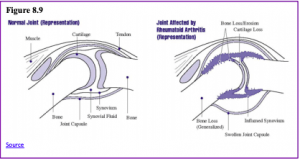
Features of Rheumatoid Arthritis
- Tender, warm, swollen joints
- Symmetrical pattern of affected joints
- Joint inflammation often affecting the wrist and finger joints closest to the hand
- Joint inflammation sometimes affecting other joints, including the neck, shoulders, elbows, hips, knees, ankles, and feet
- Fatigue, occasional fevers, a loss of energy
- Pain and stiffness lasting for more than 30 minutes in the morning or after a long rest
- Symptoms that last for many years
- Variability of symptoms among people with the disease.
About 1.5 million people (approximately 0.6%) of Americans experience rheumatoid arthritis. It occurs across all races and age groups, although the disease often begins in middle adulthood and occurs with increased frequency in older people. Like some other forms of arthritis, rheumatoid arthritis occurs much more frequently in women than in men. About two to three times as many women as men have the disease (NIH, 2016b). The lifetime risk for RA for women is 3.6% and 1.7% for men (Crowson, et al., 2011).
Genes play a role in the development of RA. However, individual genes by themselves confer only a small risk of developing the disease, as some people who have these particular genes never develop RA. Scientists think that something must occur to trigger the disease process in people whose genetic makeup makes them susceptible to rheumatoid arthritis. For instance, some scientists also think hormonal factors may be involved. In women who experience RA, the symptoms may improve during pregnancy and flare after pregnancy. Women who use oral contraceptives may increase their likelihood of developing RA. This suggests hormones, or possibly deficiencies or changes in certain hormones, may increase the risk of developing RA in a genetically susceptible person (NIH, 2016b).
Rheumatoid arthritis can affect virtually every area of a person’s life, and it can interfere with the joys and responsibilities of work and family life. Fortunately, current treatment strategies allow most people with RA to lead active and productive lives. Pain-relieving drugs and medications can slow joint damage and establishing a balance between rest and exercise can also lessen the symptoms of RA (NIH, 2016b).
Fatty liver disease (hepatic steatosis) refers to the accumulation of fat in the liver. The liver normally contains little fat, and anything below 5% of liver weight is considered normal. This disease is present in 33% of American adults. In the past, the main cause of fat accumulation in the liver was due to excessive alcohol consumption, often eventually leading to cirrhosis and liver failure. Today, increased caloric intake, especially resulting in obesity, and little physical activity are the main causes. Mild to moderate levels of hepatic steatosis can be reversed through healthy lifestyle changes (Nassir, Rector, Hammoud, & Ibdah, 2015).
Digestive Issues
Heartburn, also called acid indigestion or pyrosis, is a common digestive problem in adults and is the result of stomach acid backing up into the esophagus. Prolonged contact with the digestive juices injures the lining of the esophagus and causes discomfort. Heartburn that occurs more frequently may be due to gastroesophageal reflux disease or GERD. Normally the lower sphincter muscle in the esophagus keeps the acid in the stomach from entering the esophagus. In GERD this muscle relaxes too frequently and the stomach acid flows into the esophagus. In the U.S., 60 million people experience heartburn at least once a month, and 15 million experience it every day. Prolonged problems with heartburn can lead to more serious complications, including esophageal cancer, one of the most lethal forms of cancer in the U.S. Problems with heartburn can be linked to eating fatty or spicy foods, caffeine, smoking, and eating before bedtime (American College of Gastroenterology, 2016a).
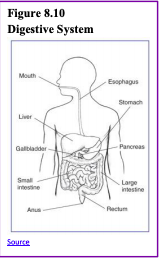
Gallstones are hard particles, including fatty materials, bile pigments, and calcium deposits, that can develop in the gallbladder. Ranging in size from a grain of sand to a golf ball, they typically take years to develop, but in some people have developed over the course of a few months. About 75% of gallstones do not create any symptoms, but those that do may cause sporadic upper abdominal pain when stones block bile or pancreatic ducts. If stones become lodged in the ducts, it may necessitate surgery or other medical intervention as it could become life-threatening if left untreated (American College of Gastroenterology, 2016b).
Gallstones are present in about 20% of women and 10% of men over the age of 55 (American College of Gastroenterology, 2016b). Risk factors include a family history of gallstones, diets high in calories and refined carbohydrates (such as, white bread and rice), diabetes, metabolic syndrome, Crohn’s disease, and obesity, which increases the cholesterol in the bile and thus increases the risk of developing gallstones (NIH, 2013).
Sleep
According to the American Academy of Sleep Medicine (Kasper, 2015) adults require at least 7 hours of sleep per night to avoid the health risks associated with chronic sleep deprivation. Less than 6 hours and more than 10 hours is also not recommended for those in middle adulthood (National Sleep Foundation, 2015). Not surprisingly, many Americans do not receive the 7-9 hours of sleep recommended. In 2013, only 59% of U.S. adults met that standard, while in 1942, 84% did (Jones, 2013). This means 41% of Americans receive less than the recommended amount of nightly sleep. Additional results included that in 1993, 67% of Americans felt they were getting enough sleep, but in 2013 only 56% felt they received as much sleep as needed. Additionally, 43% of Americans in 2013 believed they would feel better with more sleep.
Sleep problems: According to the Sleep in America poll (National Sleep Foundation, 2015), 9% of Americans report being diagnosed with a sleep disorder, and of those 71% have sleep apnea and 24% suffer from insomnia. Pain is also a contributing factor in the difference between the amount of sleep Americans say they need and the amount they are getting. An average of 42 minutes of sleep debt occur for those with chronic pain, and 14 minutes for those who have suffered from acute pain in the past week. Stress and overall poor health are also key components of shorter sleep durations and worse sleep quality. Those in midlife with lower life satisfaction experienced greater delay in the onset of sleep than those with higher life satisfaction. Delayed onset of sleep could be the result of worry and anxiety during midlife, and improvements in those areas should improve sleep. Lastly, menopause can affect a woman’s sleep duration and quality (National Sleep Foundation, 2016).
Children in the home and sleep: As expected, having children at home affects the amount of sleep one receives. According to a 2016 National Center for Health Statistics analysis (CDC, 2016) having children decreases the amount of sleep an individual receives, however, having a partner can improve the amount of sleep for both males and females. Table 8.6 illustrates the percentage of individuals not receiving seven hours of sleep per night based on parental role.
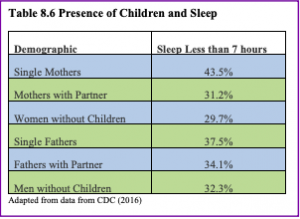
Negative consequences of insufficient sleep: There are many consequences of too little sleep, and they include physical, cognitive, and emotional changes. Sleep deprivation suppresses immune responses that fight off infection, and can lead to obesity, memory impairment, and hypertension (Ferrie et al., 2007; Kushida, 2005). Insufficient sleep is linked to an increased risk for colon cancer, breast cancer, heart disease and type 2 diabetes (Pattison, 2015). A lack of sleep can increase stress as cortisol (a stress hormone) remains elevated which keeps the body in a state of alertness and hyperarousal which increases blood pressure. Sleep is also associated with longevity. Dew et al. (2003) found that older adults who had better sleep patterns also lived longer. During deep sleep a growth hormone is released which stimulates protein synthesis, breaks down fat that supplies energy, and stimulates cell division. Consequently, a decrease in deep sleep contributes to less growth hormone being released and subsequent physical decline seen in aging (Pattison, 2015).
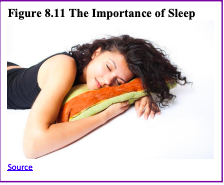
Sleep disturbances can also impair glucose functioning in middle adulthood. Caucasian, African American, and Chinese non-shift-working women aged 48–58 years who were not taking insulin-related medications, participated in the Study of Women’s Health across the Nation (SWAN) Sleep Study and were subsequently examined approximately 5 years later (Taylor et al., 2016). Body mass index (BMI) and insulin resistance were measured at two-time points. Results indicated that irregular sleep schedules, including highly variable bedtimes and staying up much later than usual, are associated in midlife women with insulin resistance, which is an important indicator of metabolic health, including diabetes risk. Diabetes risk increases in midlife women, and irregular sleep schedules may be an important reason because irregular bedtime schedules expose the body to varying levels of light, which is the most important timing cue for the body’s circadian clock. By disrupting circadian timing, bedtime variability may impair glucose metabolism and energy homeostasis.
Exercise, Nutrition, and Weight
The impact of exercise: Exercise is a powerful way to combat the changes we associate with aging. Exercise builds muscle, increases metabolism, helps control blood sugar, increases bone density, and relieves stress. Unfortunately, fewer than half of midlife adults exercise and only about 20 percent exercise frequently and strenuously enough to achieve health benefits. Many stop exercising soon after they begin an exercise program, particularly those who are very overweight. The best exercise programs are those that are engaged in regularly, regardless of the activity. A well-rounded program that is easy to follow includes walking and weight training. Having a safe, enjoyable place to walk can make the difference in whether or not someone walks regularly. Weight lifting and stretching exercises at home can also be part of an effective program. Exercise is particularly helpful in reducing stress in midlife. Walking, jogging, cycling, or swimming can release the tension caused by stressors. Learning relaxation techniques can also have healthful benefits. Exercise can be thought of as preventative health care. Promoting exercise for the 78 million “baby boomers” may be one of the best ways to reduce health care costs and improve quality of life (Shure & Cahan, 1998).
According to the Office of Disease Prevention and Health Promotion (2008), the following are exercise guidelines for adults:
- Adults should avoid being inactive. Any activity will result in some health benefits.
- For substantial health benefits, adults should engage in at least 150 minutes per week of moderate-intensity exercise OR at least 75 minutes of vigorous-intensity aerobic activity. Aerobic activity should occur for at least 10 minutes and preferably spread throughout the week.
- For more extensive health benefits, adults can increase their aerobic activity to 300 minutes per week of moderate-intensity OR 150 minutes per week of vigorous-intensity aerobic activity.
- Adults should also participate in muscle-strengthening activities that are moderate or high intensity and involve all major muscle groups on two or more days per week.
Nutritional concerns: Aging brings about a reduction in the number of calories a person requires (see Table 8.7 for estimated caloric needs in middle-aged adults). Many Americans respond to weight gain by dieting. However, eating less does not typically mean eating right and people often suffer vitamin and mineral deficiencies as a result. All adults need to be especially cognizant of the amount of sodium, sugar, and fat they are ingesting.
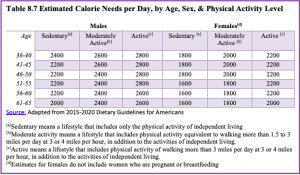
Excess Sodium: According to dietary guidelines, adults should consume less than 2,300mg (1 teaspoon) per day of sodium. The American Heart Association (2016) reports that the average sodium intake among Americans is 3440mg per day. Processed foods are the main culprits of excess sodium. High sodium levels in the diet is correlated with increased blood pressure, and its reduction does show corresponding drops in blood pressure. Adults with high blood pressure are strongly encouraged to reduce their sodium intake to 1500mg (U.S. Department of Health and Human Services & U.S. Department of Agriculture (USHHS & USDA), 2015).
Excess Fat: Dietary guidelines also suggests that adults should consume less than 10 percent of calories per day from saturated fats. The American Heart Association (2016) says optimally we should aim for a dietary pattern that achieves 5% to 6% of calories from saturated fat. In a 2000 calorie diet that is about 120 calories from saturated fat. In the average American diet about 34.3% of the diet comes from fat, with 15.0% from saturated fat (Berglund et al., 1999). Diets high in fat not only contribute to weight gain, but have been linked to heart disease, stroke, and high cholesterol.
Added Sugar: According to the recent Dietary Guidelines for Americans (USHHS & USDA, 2015) eating healthy means adults should consume less than 10 percent of calories per day from added sugars. Yet, currently, about 15% of the calories in the American adult diet come from added sugars, or about 22 teaspoons of sugar per day (NIH, 2014c). Excess sugar not only contributes to weight gain but diabetes and other health problems.
Metabolism and Weight Gain: One of the common complaints of midlife adults is weight gain, especially the accumulation of fat in the abdomen, which is often referred to as the middle-aged spread (Lachman, 2004). Men tend to gain fat on their upper abdomen and back, while women tend to gain more fat on their waist and upper arms. Many adults are surprised at this weight gain because their diets have not changed, however, their metabolism has slowed during midlife. Metabolism is the process by which the body converts food and drink into energy. The calories consumed are combined with oxygen to release the energy needed to function (Mayo Clinic, 2014b). People who have more muscle burn more calories, even at rest, and thus have a higher metabolism.
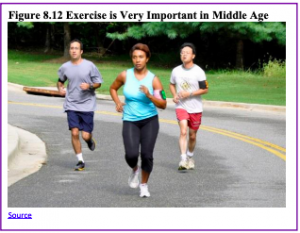
However, as you get older, the amount of muscle decreases. Consequently, fat accounts for more of one’s weight in midlife. and fat slows down the number of calories burned. To compensate, midlife adults have to increase their level of exercise, eat less, and watch their nutrition to maintain their earlier physique.
Obesity: As discussed in the early adulthood chapter, obesity is a significant health concern for adults throughout the world, and especially America. Obesity rates continue to increase and the current rate for those 40-59 is 42.8%, which is the highest percentage per age group (CDC, 2017). Being overweight is associated with a myriad of health conditions including diabetes, high blood pressure, and heart disease. New research is now linking obesity to Alzheimer’s disease. Chang et al. (2016) found that being overweight in midlife was associated with earlier onset of Alzheimer’s disease. The study looked at 1,394 men and women who were part of the Baltimore Longitudinal Study of Aging. Their average age was around 60, and they were followed for 14 years. Results indicated that people with the highest body mass index, or BMI, at age 50 were more likely to develop Alzheimer’s disease. In fact, each one-point increase in BMI was associated with getting Alzheimer’s six to seven months earlier. Those with the highest BMIs also had more brain changes typical of Alzheimer’s, even if they did not have symptoms of the disease. Scientists speculate that fat cells may produce harmful chemicals that promote inflammation in blood vessels throughout the body, including in the brain. The conclusion of the study was that a healthy BMI at midlife may delay the onset of Alzheimer’s disease.
Concluding Thoughts: Many of the changes that occur in midlife can be easily compensated for, such as buying glasses, exercising, and watching what one eats. However, the percentage of middle adults who have a significant health concern has increased in the past 15 years. According to the 2016 United Health Foundation’s America’s Health Rankings Senior Report, the next generation of seniors will be less healthy than the current seniors (United Health Foundation, 2016). The study compared the health of middle-aged Americans (50-64 years of age) in 2014 to middle-aged Americans in 1999. Results indicated that in the past 15 years the prevalence of diabetes has increased by 55% and the prevalence of obesity has increased by 25%. At the state level, Massachusetts ranked first for healthy seniors, while Louisiana ranked last. Illinois ranked 36th, while Wisconsin scored higher at 13th.
What can we conclude from this information? Lifestyle has a strong impact on the health status of midlife adults, and it becomes important for midlife adults to take preventative measures to enhance physical well-being. Those midlife adults who have a strong sense of mastery and control over their lives, who engage in challenging physical and mental activity, who engage in weight-bearing exercise, monitor their nutrition, receive adequate sleep, and make use of social resources are most likely to enjoy a plateau of good health through these years (Lachman, 2004).
Climacteric
The climacteric, or the midlife transition when fertility declines, is biologically based but impacted by the environment. During midlife, men may experience a reduction in their ability to reproduce. Women, however, lose their ability to reproduce once they reach menopause.
Female Sexual and Reproductive Health: Perimenopause refers to a period of transition in which a woman’s ovaries stop releasing eggs and the level of estrogen and progesterone production decreases. Menopause is defined as 12 months without menstruation. The average age of menopause is approximately 51, however, many women begin experiencing symptoms in their 40s. These symptoms occur during perimenopause, which can occur 2 to 8 years before menopause (Huang, 2007). A woman may first begin to notice that her periods are more or less frequent than before. After a year without menstruation, a woman is considered menopausal and no longer capable of reproduction.
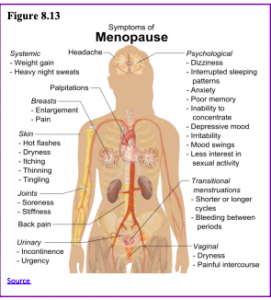
Symptoms: The symptoms that occur during perimenopause and menopause are typically caused by the decreased production of estrogen and progesterone (North American Menopause Society, 2016). The shifting hormones can contribute to the inability to fall asleep. Additionally, the declining levels of estrogen may make a woman more susceptible to environmental factors and stressors which disrupt sleep. A hot flash is a surge of adrenaline that can awaken the brain from sleep. It often produces sweat and a change of temperature that can be disruptive to sleep and comfort levels. Unfortunately, it may take time for the adrenaline to recede and allow sleep to occur again (National Sleep Foundation, 2016).
The loss of estrogen also affects vaginal lubrication which diminishes and becomes waterier and can contribute to pain during intercourse. The vaginal wall also becomes thinner, and less elastic. Estrogen is also important for bone formation and growth, and decreased estrogen can cause osteoporosis resulting in decreased bone mass. Depression, irritability, and weight gain are often associated with menopause, but they are not menopausal (Avis, Stellato & Crawford, 2001; Rossi, 2004). Weight gain can occur due to an increase in intra-abdominal fat followed by a loss of lean body mass after menopause (Morita et al., 2006). Consequently, women may need to change their lifestyle to counter any weight gain. Depression and mood swings are more common during menopause in women who have prior histories of these conditions rather than those who have not.
Additionally, the incidence of depression and mood swings is not greater among menopausal women than non-menopausal women. Figure 8.12 identifies symptoms experienced by women during menopause, however, women vary greatly in the extent to which these symptoms are experienced. Most American women go through menopause with few problems (Carroll, 2016). Overall, menopause is not seen as universally distressing (Lachman, 2004).
Hormone Replacement Therapy: Concerns about the effects of hormone replacement has changed the frequency with which estrogen replacement and hormone replacement therapies have been prescribed for menopausal women. Estrogen replacement therapy was once commonly used to treat menopausal symptoms. However, more recently, hormone replacement therapy has been associated with breast cancer, stroke, and the development of blood clots (NIH,
2007). Most women do not have symptoms severe enough to warrant estrogen or hormone replacement therapy. If so, they can be treated with lower doses of estrogen and monitored with more frequent breast and pelvic exams. There are also some other ways to reduce symptoms. These include avoiding caffeine and alcohol, eating soy, remaining sexually active, practicing relaxation techniques, and using water-based lubricants during intercourse.
Menopause and Ethnicity: In a review of studies that mentioned menopause, symptoms varied greatly across countries, geographic regions, and even across ethnic groups within the same region (Palacios, Henderson, & Siseles, 2010). For example, the Study of Women’s Health across the Nation (SWAN) examined 14,906 white, African American, Hispanic, Japanese American, and Chinese American women’s menopausal experiences (Avis et al., 2001). After controlling for age, educational level, general health status, and economic stressors, white women were more likely to disclose symptoms of depression, irritability, forgetfulness, and headaches compared to women in the other racial/ethnic groups. African American women experienced more night sweats, but this varied across research sites. Finally, Chinese American and Japanese American reported fewer menopausal symptoms when compared to the women in the other groups. Overall, the Chinese and Japanese groups reported the fewest symptoms, while white women reported more mental health symptoms and African American women reported more physical symptoms.
Cultural Differences: Cultural influences seem to also play a role in the way menopause is experienced. Further, the prevalence of language specific to menopause is an important indicator of the occurrence of menopausal symptoms in a culture. Hmong tribal women living in Australia and Mayan women report that there is no word for “hot flashes” and both groups did not experience these symptoms (Yick-Flanagan, 2013). When asked about physical changes during menopause, the Hmong women reported lighter or no periods. They also reported no emotional symptoms and found the concept of emotional difficulties caused by menopause amusing (Thurston & Vissandjee, 2005). Similarly, a study with First Nation women in Canada found there was no single word for “menopause” in the Oji-Cree or Ojibway languages, with women referring to menopause only as “that time when periods stop” (Madden, St Pierre-Hansen & Kelly, 2010).

While some women focus on menopause as a loss of youth, womanhood, and physical attractiveness, career-oriented women tend to think of menopause as a liberating experience. Japanese women perceive menopause as a transition from motherhood to a more whole person, and they no longer feel obligated to fulfill certain expected social roles, such as the duty to be a mother (Kagawa-Singer, Wu, & Kawanishi, 2002). In India, 94% of women said they welcomed menopause. Aging women gain status and prestige and no longer have to go through self- imposed menstrual restrictions, which may contribute to Indian women’s experiences (Kaur, Walia, & Singh, 2004). Overall, menopause signifies many different things to women around the world and there is no typical experience. Further, normalizing rather than pathologizing menopause is supported by research and women’s experiences.
Male Sexual and Reproductive Health: Although males can continue to father children throughout middle adulthood, erectile dysfunction (ED) becomes more common. Erectile dysfunction refers to the inability to achieve an erection or an inconsistent ability to achieve an erection (Swierzewski, 2015). Intermittent ED affects as many as 50% of men between the ages of 40 and 70. About 30 million men in the United States experience chronic ED and the percentages increase with age. Approximately 4% of men in their 40s, 17% of men in their 60s, and 47% of men older than 75 experience chronic ED.
Causes for ED are primarily due to medical conditions, including diabetes, kidney disease, alcoholism, and atherosclerosis (build-up of plaque in the arteries). Plaque is made up of fat, cholesterol, calcium and other substances found in the blood. Over time plaque builds up, hardens, and restricts the blood flow in the arteries (NIH, 2014d). This build-up limits the flow of oxygenated blood to organs and the penis. Overall, diseases account for 70% of chronic ED, while psychological factors, such as stress, depression, and anxiety account for 10%-20% of all cases. Many of these causes are treatable, and ED is not an inevitable result of aging.

Men during middle adulthood may also experience prostate enlargement, which can interfere with urination and deficient testosterone levels which decline throughout adulthood, but especially after age 50. If testosterone levels decline significantly, it is referred to as andropause or late-onset hypogonadism. Identifying whether testosterone levels are low is difficult because individual blood levels vary greatly. Low testosterone is not a concern unless it accompanied by negative symptoms such as low sex drive, ED, fatigue, loss of muscle, loss of body hair, or breast enlargement. Low testosterone is also associated with medical conditions, such as diabetes, obesity, high blood pressure, and testicular cancer. The effectiveness of supplemental testosterone is mixed, and long term testosterone replacement therapy for men can increase the risk of prostate cancer, blood clots, heart attack, and stroke (WebMD, 2016). Most men with low testosterone do not have related problems (Berkeley Wellness, 2011).
The Climacteric and Sexuality
Sexuality is an important part of people’s lives at any age, and many older adults are very interested in staying sexually active (Dimah & Dimah, 2004). According to the National Survey of Sexual Health and Behavior (NSSHB) (Center for Sexual Health Promotion, 2010), 74% of males and 70% of females aged 40-49 engaged in vaginal intercourse during the previous year, while 58% of males and 51% of females aged 50-59 did so.
Despite these percentages indicating that middle adults are sexually active, age-related physical changes can affect sexual functioning. For women, decreased sexual desire and pain during vaginal intercourse because of menopausal changes have been identified (Schick et al., 2010). A woman may also notice less vaginal lubrication during arousal which can affect overall pleasure (Carroll, 2016). Men may require more direct stimulation for an erection and the erection may be delayed or less firm (Carroll, 2016). As previously discussed men may experience erectile dysfunction or experience medical conditions (such as diabetes or heart disease) that impact sexual functioning. Couples can continue to enjoy physical intimacy and may engage in more foreplay, oral sex, and other forms of sexual expression rather than focusing as much on sexual intercourse.

The risk of pregnancy continues until a woman has been without menstruation for at least 12 months, however, and couples should continue to use contraception. People continue to be at risk of contracting sexually transmitted infections, such as genital herpes, chlamydia, and genital warts. In 2014, 16.7% of the country’s new HIV diagnoses (7,391 of 44,071) were among people 50 and older, according to the Centers for Disease Control and Prevention (2014e). This was an increase from 15.4% in 2005. Practicing safe sex is important at any age, but unfortunately, adults over the age of 40 have the lowest rates of condom use (Center for Sexual Health Promotion, 2010). This low rate of condom use suggests the need to enhance education efforts for older individuals regarding STI risks and prevention. Hopefully, when partners understand how aging affects sexual expression, they will be less likely to misinterpret these changes as a lack of sexual interest or displeasure in the partner and more able to continue to have satisfying and safe sexual relationships.
Brain Functioning
The brain at midlife has been shown to not only maintain many of the abilities of young adults but also gain new ones. Some individuals in middle age actually have improved cognitive functioning (Phillips, 2011). The brain continues to demonstrate plasticity and rewires itself in middle age based on experiences. Research has demonstrated that older adults use more of their brains than younger adults. In fact, older adults who perform the best on tasks are more likely to demonstrate bilateralization than those who perform worst. Additionally, the amount of white matter in the brain, which is responsible for forming connections among neurons, increases into the 50s before it declines.
Emotionally, the middle-aged brain is calmer, less neurotic, more capable of managing emotions, and better able to negotiate social situations (Phillips, 2011). Older adults tend to focus more on positive information and less on negative information than those younger. In fact, they also remember positive images better than those younger. Additionally, the older adult’s amygdala responds less to negative stimuli. Lastly, adults in middle adulthood make better financial decisions, which seems to peak at age 53, and show better economic understanding. Although greater cognitive variability occurs among middle adults when compared to those both younger and older, those in midlife with cognitive improvements tend to be more physically, cognitively, and socially active.
References
AARP. (2009). The divorce experience: A study of divorce at midlife and beyond. Washington, DC: AARP
Ahlborg, T., Misvaer, N., & Möller, A. (2009). Perception of marital quality by parents with small children: A follow-up study when the firstborn is 4 years old. Journal of Family Nursing, 15, 237–263.
Alterovitz, S. S., & Mendelsohn, G. A. (2013). Relationship goals of middle-aged, young-old, and old-old Internet daters: An analysis of online personal ads. Journal of Aging Studies, 27, 159–165. doi.10.1016/j.jaging.2012.12.006
American Association of Community Colleges (2016). Plus 50 community colleges: Ageless learning. Retrieved from http://plus50.aacc.nche.edu/Pages/Default.aspx
American Cancer Society. (2019). Cancer Facts and Figures 2019. Retrieved from https://www.cancer.org/content/dam/cancer- org/research/cancer-facts-and-statistics/annual-cancer-facts-and-figures/2019/cancer-facts-and-figures-2019.pdf
American Diabetes Association (2016). Standards of medical care in diabetes. Diabetes Care. 39(1), 1-112.
American Heart Association (2016). Saturated fats. Retrieved from http://www.heart.org/HEARTORG/HealthyLiving/HealthyEating/Nutrition/Saturated-Fats_UCM_301110_Article.jsp
American Psychological Association (2017). Stress in America: The state of our nation. Retrieved from https://www.apa.org/images/state-nation_tcm7-225609.pdf
American Psychological Association (2016). By the numbers: Hearing loss and mental health. Monitor on Psychology, 47(4), 9.
Anderson, E. R., & Greene, S. M. (2011). “My child and I are a package deal”: Balancing adult and child concerns in repartnering after divorce. Journal of Family Psychology, 25(5), 741-750.
Anderson, E.R., Greene, S.M., Walker, L., Malerba, C.A., Forgatch, M.S., & DeGarmo, D.S. (2004). Ready to take a chance again: Transitions into dating among divorced parents. Journal of Divorce and Remarriage, 40, 61-75.
Aquilino, W. (1991). Predicting parents’ experiences with coresidence adult children. Journal of Family Issues, 12(3), 323-342.
Arai, Y., Sugiura, M., Miura, H., Washio, M., & Kudo, K. (2000). Undue concern for other’s opinions deters caregivers of impaired elderly from using public services in rural Japan. International Journal of Geriatric Psychiatry, 15(10), 961- 968.
Armour, S. (2007, August 2). Friendships and work: A good or bad partnership? USA Today. Retrieved from http://usatoday30.usatoday.com/money/workplace/2007-08-01-work-friends_N.htm
Avis, N. E., Stellato, R., & Crawford, S. (2001). Is there a menopausal syndrome? Menopausal status and symptoms across racial/ethnic groups. Social Science and Medicine, 52(3), 345-356.
Baltes, P. B., Staudinger, U. M., & Lindenberger, U. (1999). Lifespan Psychology: Theory and Application to Intellectual Functioning. Annual Review of Psychology, 50, 471-507.
Bargh, J. A., McKenna, K. Y. A, & Fitsimons, G. G. (2002). Can you see the real me? Activation and expression of the true self on the Internet. Journal of Social Issues, 58, 33–48.
Barreto, M., Ryan, M. K., & Schmitt, M. T. (2009). The glass ceiling in the 21st century: Understanding the barriers to gender equality. Washington, DC: American Psychological Association.
Baruch, G., & Brooks-Gunn, J. (1984). Women in midlife. New York: Plenum.
Beach, S. R., Schulz, R., Yee, J. L., & Jackson, S. (2000). Negative and positive health effects of caring for a disabled spouse: Longitudinal findings from the caregiver health effects study. Psychology and Aging, 15(2), 259-271.
Beit-Hallahmi, B., & Argyle, M. (1998). Religious behavior, belief, and experience. New York: Routledge.
Bengtson, V. L. (2001). Families, intergenerational relationships, and kinkeeping in midlife. In N. M. Putney (Author) & M. E. Lachman (Ed.), Handbook of midlife development (pp. 528-579). New York: Wiley.
Berglund, L., Oliver, E. H., Fontanez, N., Holleran, S., Matthews, K., Roheim, P. S., & DELTA Investigators. (1999). HDL- subpopulation patterns in response to reductions in dietary total and saturated fat intakes in healthy subjects. American Journal of Clinical Nutrition, 70, 992-1000.
Berkeley Wellness. (2011). The lowdown on low testosterone. Retrieved from http://www.berkeleywellness.com/self- care/sexual-health/article/lowdown-low-testosterone
Besen, E., Matz-Costa, C., Brown, M., Smyer, M. A., & Pitt-Catsouphers, M. (2013). Job characteristics, core self-evaluations, and job satisfaction. International Journal of Aging & Human Development, 76(4), 269-295.
Billings, A. G., & Moos, R. H. (1981). The role of coping responses and social resources in attenuating the stress of life events. Journal of Behavioral Medicine, 4, 139–157.
Birditt, K. S., & Antonucci, T.C. (2012). Till death do us part: Contexts and implications of marriage, divorce, and remarriage across adulthood. Research in Human Development, 9(2), 103-105.
Borland, D. C. (1982). A cohort analysis approach to the empty-nest syndrome among three ethnic groups of women: A theoretical position. Journal of Marriage and the Family, 44, 117–129.
Borzumato-Gainey, C., Kennedy, A., McCabe, B., & Degges-White, S. (2009). Life satisfaction, self-esteem, and subjective age in women across the life span. Adultspan Journal, 8(1), 29-42.
Bouchard, G. (2013). How do parents reaction when their children leave home: An integrative review. Journal of Adult Development, 21, 69-79.
Bromberger, J. T., Kravitz, H. M., & Chang, Y. (2013). Does risk for anxiety increase during the menopausal transition? Study of Women’s Health Across the Nation (SWAN). Menopause, 20(5), 488-495.
Brown, L. H., & DeRycke, S. B. (2010). The kinkeeping connection: Continuity, crisis and consensus. Journal of Intergenerational Relationships, 8(4), 338-353, DOI: 10.1080/15350770.2010.520616
Brown, S. L., & Lin, I. (2013). The gray divorce revolution: Rising divorce among middle aged and older adults 1990-2010. National Center for Family & Marriage Research Working Paper Series. Bowling Green State University. https://www.bgsu.edu/content/dam/BGSU/college-of-arts-and- sciences/NCFMR/ documents/Lin/The-Gray- Divorce.pdf
Bureau of Labor Statistics. (2019). The employment situation-June 2019. Retrieved from: https://www.bls.gov/news.release/pdf/empsit.pdf
Busse, E. W. (1969). Theories of aging. In E. W. Busse & E/. Pfeiffer (Eds.), Behavior and adaptation in later life (pp. 11-31). Boston, MA: Little Brown.
Carmichael, C. L., Reis, H. T., & Duberstein, P. R. (2015). In your 20s it’s quantity, in your 30s it’s quality: The prognostic value of social activity across 30 years of adulthood. Psychology and Aging, 30(1), 95-105.
Carroll, J. L. (2016). Sexuality now: Embracing diversity (5th ed.). Boston, MA: Cengage Learning.
Carver, C. S., Scheier, M. F., & Weintraub, J. K. (1989). Assessing coping strategies: A theoretically based approach. Journal of Personality and Social Psychology, 56, 267–283.
Center for Sexual Health Promotion. (2010). National survey of sexual health and behavior. Retrieved from http://www.sexualhealth.indiana.edu
Centers for Disease Control (2014a). About high blood pressure. Retrieved from http://www.cdc.gov/bloodpressure/about.htm
Centers for Disease Control and Prevention. (2014b). Behaviors that increase the risk for high blood pressure. Retrieved from http://www.cdc.gov/bloodpressure/behavior.htm
Centers for Disease Control and Prevention. (2014c). Measuring high blood pressure. Retrieved from http://www.cdc.gov/bloodpressure/measure.htm
Centers for Disease Control and Prevention. (2014d). National diabetes statistics report, 2014. Retrieved from http://www.cdc.gov/diabetes/pubs/statsreport14/national-diabetes-report-web.pdf
Centers for Disease Control and Prevention. (2014e). Diagnoses of HIV infection among adults aged 50 years and older in the United States and dependent areas 2010–2014. HIV surveillance report, 21(2), 1-69. Retrieved from http://www.cdc.gov/hiv/pdf/library/reports/surveillance/cdc-hiv-surveillance-supplemental-report-vol-21-2.pdf
Centers for Disease Control and Prevention. (2015). Facts about high cholesterol. Retrieved from http://www.cdc.gov/cholesterol/facts.htm
Centers for Disease Control and Prevention. (2016). The National Center for Health Statistics. Retrieved from https://www.cdc.gov/nchs/index.htm
Centers for Disease Control and Prevention. (2017). National diabetes statistics report, 2017. Retrieved from: https://www.cdc.gov/diabetes/pdfs/data/statistics/national-diabetes-statistics-report.pdf
Chang, Y. F., An, Y., Bigel, M., Wong, D. F., Troncoso, J. C., O’Brien, R. J., Breitner, J. C., Ferruci, L., Resnick, S. M., & Thanbisetty, M. (2016). Midlife adiposity predicts earlier onset of Alzheimer’s dementia, neuropathology and presymptomatic cerebral amyloid accumulation. Molecular Psychiatry, 21(7), 910-915.
Charness, N., & Krampe, R. T. (2006). Aging and expertise. In K. Ericsson, N. Charness & P. Feltovich (Eds.), Cambridge Handbook of expertise and expert performance. Cambridge, United Kingdom: Cambridge University Press.
Cherlin, A. J., & Furstenberg, F. F. (1986). The new American grandparent: A place in the family, a life apart. New York: Basic Books.
Cohen, S., & Wills, T. A. (1985). Stress, social support, and the buffering hypothesis. Psychological Bulletin, 98, 310–357.
Crawford, S. & Channon, S. (2002). Dissociation between performance on abstract tests of executive function and problem solving in real life type situations in normal aging. Aging and Mental Health, 6, 12-21.
Crist, L. A., Champagne, C. M., Corsino, L., Lien, L. F., Zhang, G., & Young, D. R. (2012). Influence of change in aerobic fitness and weight on prevalence of metabolic syndrome. Preventing Chronic Disease 9,110171. doi: http://dx.doi.org/10.5888/pcd9.110171
Crowson, C. S., Matteson, E. L., Myasoedova, E., Michet, C. J., Ernste, F. C., Warrington, K. J., …Gabriel, S. E. (2011). The lifetime risk of adult-onset rheumatoid arthritis and other inflammatory autoimmune rheumatic diseases. Arthritis and Rheumatism, 63(3), 633-639. doi: 10.1002/art.30155.
Csikszentmihalyi, M. (1990). Flow: The psychology of optimal experience. New York: Harper Perennial Modern Classics.
Csikszentmihalyi, M. (1996). Creativity: Flow and the psychology of discovery and invention. New York: Harper
Collins. Dawes, P., DicMonrokinson, C., Emsley, R., Bishop, P. N., Cruickshanks, K. J., Edmundson-Jones, M., …. Munro, K. (2014). Vision impairment and dual sensory problems in middle age. Ophthalmic Physiological Optics, 34, 479–488. doi: 10.1111/opo.12138479
Degges-White, S., & Myers, J, E. (2006). Women at midlife: An exploration of chronological age, subjective age, wellness, and life satisfaction, Adultspan Journal, 5, 67-80.
DeLongis, A., Folkman, S., & Lazarus, R. S. (1988). The impact of daily stress on health and mood: Psychological and social resources as mediators. Journal of Personality and Social Psychology, 54, 486–495.
Dennerstein, L., Dudley, E., & Guthrie, J. (2002). Empty nest or revolving door? A prospective study of women’s quality of life in midlife during the phase of children leaving and re-entering the home. Psychological Medicine, 32, 545–550.
DePaulo, B. (2014). A singles studies perspective on mount marriage. Psychological Inquiry, 25(1), 64-68. doi: 10.1080/1047840X.2014.878173
Desilver, D. (2016). In the U. S. and abroad, more young adults are living with their parents. Retrieved from: https://www.pewresearch.org/fact-tank/2016/05/24/in-the-u-s-and-abroad-more-young-adults-are-living-with-their- parents/
de St. Aubin, E., & Mc Adams, D. P. (1995). The relation of generative concern and generative action to personality traits, satisfaction/happiness with life and ego development. Journal of Adult Development, 2, 99-112.
De Vaus, D. & McAllister, I. (1987). Gender differences in religion: A test of the structural location theory. American Sociological Review, 52, 472-481.
Dew, M. A., Hoch, C. C., Buysse, D. J., Monk, T. H., Begley, A. E., Houck, P. R.,…Reynolds, C. F., III. (2003). Healthy older adults’ sleep predicts all-cause mortality at 4 to 19 years of follow-up. Psychosomatic Medicine, 65(1), 63–73.
Dimah, K., & Dimah, A. (2004). Intimate relationships and sexual attitudes of older African American men and women. The Gerontologist, 44, 612-613.
Drake, B. (2013). Another gender gap: Men spend more time in leisure activities. Pew Research Center. Retrieved from http://www.pewresearch.org/fact-tank/2013/06/10/another-gender-gap-men-spend-more-time-in-leisure-activities/
Dunér, A., & Nordstrom, M. (2007). The roles and functions of the informal support networks of older people who receive formal support: A Swedish qualitative study. Ageing & Society, 27, 67– 85. doi:10.1017/ S0144686X06005344
Easterlin, R. A. (2006). Life cycle happiness and its sources: Intersections of psychology, economics, and demography. Journal of Economic Psychology, 27, 463-482.
Eastley, R., & Wilcock, G. K. (1997). Prevalence and correlates of aggressive behaviors occurring in patients with Alzheimer’s disease. International Journal of Geriatric Psychiatry, 12, 484-487.
Elsesser, L., & Peplau, L. A. (2006). The glass partition: Obstacles to cross-sex friendships at work. Human Relations, 59(8), 1077–1100.
Emslie, C., Hunt, K., & Lyons, A. (2013. The role of alcohol in forging and maintaining friendships amongst Scottish men in midlife. Health Psychology, 32(10, 33-41.
Ericsson, K. A., Feltovich, P. J., & Prietula, M. J. (2006). Studies of expertise from psychological perspectives. In K. Ericsson, N. Charness & P. Feltovich (Eds.), Cambridge Handbook of expertise and expert performance. Cambridge, UK: Cambridge University Press.
Erikson, E. (1950). Childhood and society. New York: Norton & Company. Erikson, E. (1959). Identity and the life cycle. New York: Norton & Company. Erikson, E. (1982). The life cycle completed. New York: Norton & Company.
Fehr, B. (2008). Friendship formation. In S. Sprecher, A. Wenzel, & J. Harvey (Eds.), Handbook of Relationship Initiation (pp.29–54). New York, NY: Psychology Press.
Ferrie, J. E., Shipley, M. J., Cappuccio, F. P., Brunner, E., Miller, M. A., Kumari, M., & Marmot, M. G. (2007). A prospective study of change in sleep duration: Associations with mortality in the Whitehall II cohort. Sleep, 30(12), 1659.
Ford, E. S., Li, C., & Zhao, G. (2010). Prevalence and correlates of metabolic syndrome based on a harmonious definition among adults in the US. Journal of Diabetes, 2(3), 180-193.
Friedman, M., & Rosenman, R. (1959). Association of specific overt behaviour pattern with blood and cardiovascular findings. Journal of the American Medical Association, 169, 1286–1296.
Fry, R. (2017). It’s becoming more common for young adults to live at home-and for longer stretches. Retrieved from: https://www.pewresearch.org/fact-tank/2017/05/05/its-becoming-more-common-for-young-adults-to-live-at-home-and- for-longer-stretches/ft_17-05-03_livingathome_bygen2/
Füllgrabe, C., Moore, B. C. J., & Stone, M. A. (2015). Age-group differences in speech identification despite matched audio metrically normal hearing: contributions from auditory temporal processing and cognition. Frontiers in Aging Neuroscience, 6, 1-25. doi:10.3389/fnagi.2014.00347
Fung, H. H. (2013). Aging in culture. Gerontologist, 53(3), 369-377.
Gerstel, N., & Gallagher, S. K. (1993). Kinkeeping and distress: Gender, recipients of care, and work–family conflict. Journal of Marriage and the Family, 55, 598–607.
Gibbons, C., Creese, J., Tran, M., Brazil, K., Chambers, L., Weaver, B., & Bedard, M. (2014). The psychological and health consequences of caring for a spouse with dementia: A critical comparison of husbands and wives. Journal of Women & Aging, 26, 3-21.
Gilleard, C., & Higgs, P. (2000). Cultures of aging: Self, citizen and the body. Upper Saddle River, NJ: Prentice Hall Publishers.
Goldscheider, F., & Kaufman, G. (2006). Willingness to stepparent: Attitudes about partners who already have children. Journal of Family Issues, 27, 1415 – 1436.
Goldscheider, F., & Sassler, S. (2006). Creating stepfamilies: Integrating children into the study of union formation. Journal of Marriage and Family, 68, 275 – 291.
Gorchoff, S. M., John, O. P., & Helson, R. (2008). Contextualizing change in marital satisfaction during middle age. Psychological Science, 19, 1194–1200.
Gottman, J. M., & Levenson, R. W. (2000). The timing of divorce: Predicting when a couple will divorce over a 14-year period. Journal of Marriage & the Family, 62, 737-745.
Greene, S. M., Anderson, E. R., Hetherington, E., Forgtch, M. S., & DeGarmo, D. S. (2003). Risk and resilience after divorce. In F. Walsh (Ed.), Normal family processes: Growing diversity and complexity (3rd ed., pp. 96-120). New York: Guilford Press.
Greenfield, E. A., & Marks, N. F. (2006). Linked lives: Adult children’s problems and their parents’ psychological and relational well-being. Journal of Marriage and Family, 68, 442-454.
Greenfield, E. A., Vaillant, G. E., & Marks, N. F. (2009). Do formal religious participation and spiritual perceptions have independent linkages with diverse dimensions of psychological well-being? Journal of Health and Social Behavior, 50, 196-212.
Gripsrud, J. (2007). Television and the European public sphere. European Journal of Communication, 22, 479-492.
Grzywacz, J. G. & Keyes, C. L. (2004). Toward health promotion: Physical and social behaviors in complete health. Journal of Health Behavior, 28(2), 99-111.
Ha, J., Hong, J., Seltzer, M. M., & Greenberg, J. S. (2008). Age and gender differences in the well-being of midlife and aging parents with children with mental health or developmental problems: Report of a national study. Journal of Health and Social Behavior, 49, 301-316.
Harrison, J., Barrow, S., Gask, L., & Creed, F. (1999). Social determinants of GHQ score by postal survey. Journal of Public Health Medicine, 21, 283–288. doi:10.1093/pubmed/21.3.283
Hawkley, L. C., Hughes, M. E., Waite, L. J., Masi, C. M., Thisted, R. A., & Cacioppo, J. T. (2008). From social structural factors to perceptions of relationship quality and loneliness: The Chicago health, aging, and marital status transitions and health outcomes social relations study. The Journals of Gerontology: Series B: Psychological Sciences and Social Sciences, 63, 375–384. doi:10.1093/geronb/ 63.6.S375
Hayslip Jr., B., Henderson, C. E., & Shore, R. J. (2003). The Structure of Grandparental Role Meaning. Journal of Adult Development, 10(1), 1-13.
Hedlund, J., Antonakis, J., & Sternberg, R. J. (2002). Tacit knowledge and practical intelligence: Understanding the lessons of experience. Retrieved from http://www.au.af.mil/au/awc/awcgate/army/ari_tacit_knowledge.pdf
Herman-Stabl, M. A., Stemmler, M., & Petersen, A. C. (1995). Approach and avoidant coping: Implications for adolescent mental health. Journal of Youth and Adolescence, 24, 649–665.
Hetherington, E. M. & Kelly, J. (2002). For better or worse: Divorce reconsidered. New York, NY: Norton.
Holland, K. (2014). Why America’s campuses are going gray. CNBC. Retrieved from http://www.cnbc.com/2014/08/28/why- americas-campuses-are-going-gray.html
Holt-Lunstad, J., Smith, T. B., & Layton, J. B. (2010). Social relationships and mortality risk: a meta-analytic review. PLoS Medicine, 7(7), e1000316.
Hooker, E., & Pressman, S. (2016). The healthy life. NOBA. Retrieved from http://nobaproject.com/modules/the-healthy-life
Horn, J. L., Donaldson, G., & Engstrom, R. (1981). Apprehension, memory, and fluid intelligence decline in adulthood. Research on Aging, 3(1), 33-84.
House, J. S., Landis, K. R., & Umberson, D. (1988). Social relationships and health. Science, 241, 540–545
Hu, G., Qiao, Q., Tuomilehto, J., Balkau, B., Borch, Johnsen, K., & Pyorala, K. (2004). Prevalence of metabolic syndrome and its relation to all-cause and cardiovascular mortality in non-diabetic European men and women. Archives of Internal Medicine, 164(10), 1066-1076.
Huang, J. (2007). Hormones and female sexuality. In M. Tepper & A. F. Owens (Eds.), Sexual Health, Vol 2: Physical Foundations (pp. 43-78). Westport, CT: Praeger.
Humes, L. E., Kewley-Port, D., Fogerty, D., & Kinney, D. (2010). Measures of hearing threshold and temporal processing across the adult lifespan. Hearing Research, 264(1/2), 30-40. doi:10.1016/j.heares.2009.09.010
International Labour Organization. (2011). Global Employment Trends: 2011. Retrieved from http://www.ilo.org/wcmsp5/groups/public/@dgreports/@dcomm/@publ/documents/publication/wcms_150440.pdf
Iribarren, C., Sidney, S., Bild, D. E., Liu, K., Markovitz, J. H., Roseman, J. M., & Matthews, K. (2000). Association of hostility with coronary artery calcification in young adults. Journal of the American Medical Association, 283, 2546–2551.
Jackson, G. R. & Owsley, C. (2000). Scotopic sensitivity during adulthood. Vision Research, 40 (18), 2467-2473. doi:10.1016/S0042-6989(00)00108-5
Jones, J. M. (2013). In U.S., 40% Get Less than Recommended Amount of Sleep. Gallup. Retrieved from http://www.gallup.com/poll/166553/less-recommended- amount sleep.aspx?g_source=sleep%202013&g_medium=search&g_campaign=tiles
Kagawa-Singer, M., Wu, K., & Kawanishi, Y. (2002). Comparison of the menopause and midlife transition between Japanese American and European American women. Medical Anthropology Quarterly, 16(1), 64-91.
Kang, S. W., & Marks, N. F. (2014). Parental caregiving for a child with special needs, marital strain, and physical health: Evidence from National Survey of Midlife in the U.S. 2005. Contemporary Perspectives in Family Research, 8A, 183- 209.
Karakelides, H., & Nair, K. S. (2005). Sarcopenia of aging and its metabolic impact. Current Topics in Developmental Biology, 68, 123-148.
Kasper, T. (2015). Why you only need 7 hours of sleep. American Academy of Sleep Medicine. Retrieved from http://sleepeducation.org/news/2015/06/03/why-you-only-need-7-hours-of-sleep
Kaufman, B. E., & Hotchkiss, J. L. 2003. The economics of labor markets (6th ed.). Mason, OH: Thomson South-Western.
Kaufman, S. B., & Gregoire, C. (2016). How to cultivate creativity. Scientific American Mind, 27(1), 62-67.
Kaur, S., Walia, I., & Singh, A. (2004). How menopause affects the lives of women in suburban Chandigarh, India. Climacteric, 7(2), 175-180.
Knowles, M. S., Holton, E. F., & Swanson, R. A. (1998). The adult learner: A neglected species. Houston: Gulf Pub., Book Division.
Kochanek, K. D., Murphy, S. L., Xu, J., & Arias, E. (2019). Deaths: Final data for 2017. National Vital Statistics Reports, 68(9), 1-77.
Kouzis, A. C., & Eaton, W. W. (1998). Absence of social networks, social support, and health services utilization. Psychological Medicine, 28, 1301–1310. doi:10.1017/S0033291798007454
Krause, N. A., Herzog, R., & Baker, E. (1992). Providing support to others and well-being in later life. Journal of Gerontology: Psychological Sciences, 47, P300-311.
Kühnel, J., & Sonnentag, S. (2011). How long do you benefit from vacation? A closer look at the fade-out vacation effects. Journal of Organizational Behavior, 32, 125-143.
Kushida, C. (2005). Sleep deprivation: basic science, physiology, and behavior. London, England: Informal Healthcare.
Lachman, M. E. (2004). Development in midlife. Annual Review of Psychology, 55(1), 305-331. doi: 10.1146/annurev.psych.55.090902.141521
Landsford, J. E., Antonucci, T.C., Akiyama, H., & Takahashi, K. (2005). A quantitative and qualitative approach to social relationships and well-being in the United States and Japan. Journal of Comparative Family Studies, 36, 1-22.
Leach, M. S., & Braithwaite, D. O. (1996). A binding tie: Supportive communication of family kinkeepers. Journal of Applied Communication Research, 24, 200–216.
Lee, B., Lawson, K. M., Chang, P., Neuendorf, C., Dmitrieva, N. O., & Ameida, D. H. (2015). Leisure-time physical activity moderates the longitudinal associations between work-family spillover and physical health. Journal of Leisure Research, 47(4), 444-466.
Levinson, D. J. (1978). The seasons of a man’s life. New York: Knopf.
Livingston, G. (2014). Four in ten couples are saying I do again. In Chapter 3. The differing demographic profiles of first-time marries, remarried and divorced adults. Pew Research Center. Retrieved from http://www.pewsocialtrends.org/2014/11/14/chapter-3-the-differing-demographic-profiles-of-first-time-married- remarried-and-divorced-adults/
Madden, S., St Pierre-Hansen, N., & Kelly L. (2010). First Nations women’s knowledge of menopause: Experiences and perspectives. Canadian Family Physician, 56(9), e331-e337.
Malik, S. (2004). Impact of the metabolic syndrome on mortality from coronary heart disease, cardiovascular disease, and all causes in United States adults. Circulation, 110(10), 1245-1250.
Malone, J. C., Liu, S. R., Vaillant, G. E., Rentz, D. M., & Waldinger, R. J. (2016). Midlife Eriksonian psychosocial development: Setting the stage for late-life cognitive and emotional health. Developmental Psychology, 52(3), 496-508.
Marketing Charts Staff. (2014). Are young people watching less TV? Retrieved from http://www.marketingcharts.com/television/are-young-people-watching-less-tv-24817/
Martin, L. J. (2014). Aging changes in hair and nails. U.S. National Library of Medicine. Retrieved from https://www.nlm.nih.gov/medlineplus/ency/article/004005.htm
Matthews, K. A., Glass, D. C., Rosenman, R. H., & Bortner, R. W. (1977). Competitive drive, pattern A, and coronary heart disease: A further analysis of some data from the Western Collaborative Group Study. Journal of Chronic Diseases, 30, 489–498.
Mayo Clinic. (2014a). Heart disease. Retrieved from http://www.mayoclinic.org/diseases-conditions/heart- disease/basics/definition/con-20034056
Mayo Clinic. (2014b). Metabolism and weight loss: How you burn calories. Retrieved from http://www.mayoclinic.org/healthy- lifestyle/weight-loss/in-depth/metabolism/art-20046508
McKenna, K. A. (2008) MySpace or your place: Relationship initiation and development in the wired and wireless world. In S. Sprecher, A. Wenzel, & J. Harvey (Eds.), Handbook of relationship initiation (pp. 235–247). New York, NY: Psychology Press.
McKenna, K. A., Green, A. S., & Gleason, M. E. J. (2002). Relationship formation on the Internet: What’s the big attraction? Journal of Social Issues, 58, 9–31.
Metlife. (2011). Metlife study of caregiving costs to working caregivers: Double jeopardy for baby boomers caring for their parents. Retrieved from http://www.caregiving.org/wp-content/uploads/2011/06/mmi-caregiving-costs-working- caregivers.pdf
Maillard, P., Sashardi, S., Beiser, A., Himail, J. J., Au, R., Fletcher, E., …. DeCarli, C. (2012). Effects of systolic blood pressure on white-matter integrity in young adults in the Farmington Heart Study: A cross-sectional study. The Lancet: Neurology, 11(12), 1039-1047.
Miller, T. Q., Smith, T. W., Turner, C. W., Guijarro, M. L., & Hallet, A. J. (1996). Meta-analytic review of research on hostility and physical health. Psychological Bulletin, 119, 322–348.
Mitchell, B. A., & Lovegreen, L. D. (2009). The empty nest syndrome in midlife families: A multimethod exploration of parental gender differences and cultural dynamics. Journal of Family Issues, 30, 1651–1670.
Montenegro, X. P. (2003). Lifestyles, dating, and romance: A study of midlife singles. Washington, DC: AARP.
Monthly Labor Review. (2013). Percentage of the non-institutionalized civilian workforce employed by gender & age. Retrieved from http://www.bls.gov/cps/cps_aa2013.htm
Moravec, C. S. (2008). Biofeedback therapy in cardiovascular disease: rationale and research overview. Cleveland Clinic Journal of Medicine, 75, S35–S38.
Morita, Y., Iwamoto, I., Mizuma, W., Kuwahata, T., Matsuo, T., Yoshinaga, M., &Douchi, T. (2006). Precedence of the shift of body-fat distribution over the change in body composition after menopause. Journal of Obstetrics and Gynecology, 32, 513-516.
Morley, J. E., Baumgartner, R. N., Roubenoff, R., Mayer, J., & Nair, K. S. (2001). Sarcopenia. Journal of Laboratory and Clinical Medicine, 137(4), 231-243.
Moskowitz, R. J. (2014). Wrinkles. U. S. National Library of Medicine. Retrieved from https://www.nlm.nih.gov/medlineplus/ency/article/003252.htm
Nakamura, J., & Csikszentmihalyi, M. (2002). The concept of flow. In C. R. Snyder & S. J. Lopez (Eds.), Handbook of positive psychology (pp. 89-105). New York: Oxford University Press.
Nassir, F., Rector, S., Hammoud, G.M., & Ibdah, J.A. (2015). Pathogenesis and prevention of hepatic steatosis. Gastroenterology & Hepatology, 11(3), 167-175.
National Alliance for Caregiving. (2015). Caregiving in the U.S. 2015. Retrieved from http://www.caregiving.org/caregiving2015.
National Eye Institute. (2009). Facts about floaters. Department of Health and Human Services. Retrieved from https://nei.nih.gov/health/floaters/floaters
National Eye Institute. (2013). Facts about dry eye. Department of Health and Human Services. Retrieved from https://nei.nih.gov/health/dryeye/dryeye
National Eye Institute. (2015). Facts about diabetic eye disease. Retrieved from: https://nei.nih.gov/health/diabetic/retinopathy
National Eye Institute. (2016). Facts about presbyopia. Department of Health and Human Services. Retrieved from https://nei.nih.gov/health/errors/presbyopia
National Institutes of Health. (2007). Menopause: MedlinePlus Medical Encyclopedia. Retrieved from http://www.nlm.nih.gov/medlineplus/ency/article/000894.htm
National Institutes of Health. (2013). Gallstones. U.S. Department of Health and Human Services. Retrieved from http://www.niddk.nih.gov/health-information/health-topics/digestive-diseases/gallstones/Pages/facts.aspx
National Institutes of Health. (2014a). The A1C and diabetes. Retrieved from http://www.niddk.nih.gov/health- information/health-topics/diagnostic-tests/a1c-test-diabetes/Pages/index.aspx
National Institutes of Health (2014b). Age changes in the lungs. Retrieved from https://www.nlm.nih.gov/medlineplus/ency/article/004011.htm
National Institutes of Health (2014c). Sweet stuff: How sugars and sweeteners affect your health. Retrieved from https://newsinhealth.nih.gov/issue/oct2014/feature1
National Institutes of Health. (2014d). What is atherosclerosis? Retrieved from http://www.nhlbi.nih.gov/health/health- topics/topics/atherosclerosis
National Institutes of Health. (2015). Cancer. Retrieved from https://www.cancer.gov/about-cancer/understanding/what-is-cancer
National Institutes of Health. (2016a). Facts about diabetes. Retrieved from http://www.niddk.nih.gov/health-information/health- topics/Diabetes/diabetes-facts/Pages/default.aspx
National Institutes of Health (2016b). Handout on Health: Rheumatoid Arthritis. Retrieved from http://www.niams.nih.gov/health%5Finfo/rheumatic%5Fdisease/
National Institutes of Health. (2016c). Older drivers: How health affects driving. Retrieved from http://nihseniorhealth.gov/olderdrivers/howhealthaffectsdriving/01.html
National Sleep Foundation. (2015). 2015 Sleep in America™ poll finds pain a significant challenge when it comes to Americans’ sleep. National Sleep Foundation. Retrieved from https://sleepfoundation.org/media-center/press-release/2015-sleep- america-poll
National Sleep Foundation. (2016). Menopause and Insomnia. National Sleep Foundation. Retrieved from https://sleepfoundation.org/ask-the-expert/menopause-and-insomnia
Neidleman, M. T., Wambacq, I., Besing, J., Spitzer, J. B., & Koehnke, J. (2015). The Effect of Background Babble on Working Memory in Young and Middle-Aged Adults. Journal of the American Academy of Audiology, 26(3), 220-228. doi:10.3766/jaaa.26.3.3
Neugarten, B. L. (1968). The awareness of middle aging. In B. L. Neugarten (Ed.), Middle age and aging (pp. 93-98). Chicago: University of Chicago Press.
Neugarten, B. L., & Weinstein, K. K. (1964). The changing American grandparent. Journal of Marriage and the Family, 26, 199–204.
Newton, T., Buckley, A., Zurlage, M., Mitchell, C., Shaw, A., & Woodruff-Borden, J. (2008). Lack of a close confidant: Prevalence and correlates in a medically underserved primary care sample. Psychology, Health & Medicine, 13, 185– 192. doi:10.1080/ 13548500701405491
Nimrod, G., Kleiber, D. A., & Berdychevesky, L. (2012). Leisure in coping with depression. Journal of Leisure Research, 44(4), 414-449.
Norman, G. (2005). Research in clinical reasoning: Past history and current trends. Medical Education, 39, 418–427. doi:10.1111/j.1365-2929.2005.02127.x
North American Menopause Society. (2016). Menopause FAQs: Understanding the symptoms. Retrieved from Http://www.menopause.org/for-women/expert-answers-to-frequently-asked-questions-about-menopause/menopause- faqs-understanding-the-symptoms
Nwankwo T., Yoon S. S., Burt, V., & Gu, Q. (2013) Hypertension among adults in the US: National Health and Nutrition Examination Survey, 2011-2012. NCHS Data Brief, No. 133. Hyattsville, MD: National Center for Health Statistics, Centers for Disease Control and Prevention, US Dept of Health and Human Services.
Office of Disease Prevention and Health Promotion. (2008). The physical activity guidelines for Americans. Retrieved from http://health.gov/paguidelines/?_ga=1.177233189.1671103883.1467228401
Organisation for Economic Cooperation and Development. (2016). Average annual hours actually worked per worker. OECD Stat. Retrieved from http://stats.oecd.org/Index.aspx?DataSetCode=ANHRS
Palacios, S., Henderson V. W., & Siseles, N. (2010). Age of menopause and impact of climacteric symptoms by geographical region. Climacteric, 13(5), 419-428.
Parker, K. & Patten, E. (2013). The sandwich generation: Rising financial burdens for middle-aged Americans. Pew Research Center. Retrieved from http://www.pewsocialtrends.org/2013/01/30/the-sandwich-generation/
Patel, C., Marmot, M. G., & Terry, D. J. (1981). Controlled trial of biofeedback-aided behavioural methods in reducing mild hypertension. British Medical Journal (Clinical research ed.), 282, 2005–2008.
Pattison, K. (2015). Sleep deficit. Experience Life. Retrieved from https://experiencelife.com/article/sleep-deficit/
Payne, K. K. (2015). The remarriage rate: Geographic variation, 2013. National Center for Family & Marriage Research. Retrieved from http://bgsu.edu/ncfmr/resources/data/family-profiles/payne-remarriage-rate-fp-15-08.html
Peterson, B. E. & Duncan, L. E. (2007). Midlife women’s generativity and authoritarianism: Marriage, motherhood, and 10 years of aging. Psychology and Aging, 22(3), 411-419.
Peterson, B. E., Smirles, K. A., & Wentworth, P. A. (1997). Generativity and authoritarianism: Implications for personality, political involvement, and parenting. Journal of Personality and Social Psychology, 72, 1202-1216.
Pew Research Center. (2010). The return of the multi-generational family household. Retrieved from http://www.pewsocialtrends.org/2010/03/18/the-return-of-the-multi-generational-family-household/
Pew Research Center. (2010a). How the great recession has changed life in America. Retrieved from http://www.pewsocialtrends.org/2010/06/30/how-the-great-recession-has-changed-life-in-america/
Pew Research Center. (2010b). Section 5: Generations and the great recession. Retrieved from http://www.people- press.org/2011/11/03/section-5-generations-and-the-great-recession/
Pew Research Center. (2015). Caring for aging parents. Family support in graying societies. Retrieved from http://www.pewsocialtrends.org/2015/05/21/4-caring-for-aging-parents/
Pew Research Center. (2016). The Gender gap in religion around the world. Retrieved from http://www.pewforum.org/2016/03/22/the-gender-gap-in-religion-around-the-world/
Phillips, M. L. (2011). The mind at midlife. American Psychological Association. Retrieved from http://www.apa.org/monitor/2011/04/mind-midlife.aspx
Proctor, D. N., Balagopal, P., & Nair, K. S. (1998). Age-related sarcopenia in humans is associated with reduced synthetic rates of specific muscle proteins. Journal of Nutrition, 128(2 Suppl.), 351S-355S.
Project Time-Off (2016). The state of American vacation: How vacation became a casualty of our work culture. Retrieved from http://www.projecttimeoff.com/research/state-american-vacation-2016
Qian, X., Yarnal, C. M., Almeida, D. M. (2013). Does leisure time as a stress coping source increase affective complexity? Applying the Dynamic Model of Affect (DMA). Journal of Leisure Research, 45(3), 393-414.
Ray, R., Sanes, M., & Schmitt, J. (2013). No-vacation nation revisited. Center for Economic Policy Research. Retrieved from http://cepr.net/publications/reports/no-vacation-nation-2013
Ray, R., & Schmitt, J. (2007). No vacation nation USA – A comparison of leave and holiday in OECD countries. Retrieved from http://www.law.harvard.edu/programs/lwp/papers/No_Holidays.pdf
Research Network on Successful Midlife Development. (2007, February 7). Midlife Research – MIDMAC WebSite. Retrieved from http://midmac.med.harvard.edu/research.html
Riordan, C. M., & Griffeth, R. W. (1995). The opportunity for friendship in the workplace: An underexplored construct. Journal of Business and Psychology, 10, 141–154.
Rossi, A. S. (2004). The menopausal transition and aging process. In How healthy are we: A national study of health in midlife. (pp. 550-575). Chicago: University of Chicago Press.
Rubin, M., Scevak, J., Southgate, E., Macqueen, S., Williams, P., & Douglas, H. (2018). Older women, deeper learning, and greater satisfaction at university: Age and gender predict university students’ learning approach and degree satisfaction. Diversity in Higher Education, 11(1), 82-96.
Saad, L. (2014). The 40 hour work week is actually longer – by 7 hours. Gallop. Retrieved from http://www.gallup.com/poll/175286/hour-workweek-actually-longer-seven-hours.aspx
Salmon, P. (2001). Effects of physical exercise on anxiety, depression, and sensitivity to stress: A unifying theory. Clinical Psychology Review, 21(1), 33–61.
Salthouse, T. A. (2004). What and when of cognitive aging. Current Directions in Psychological Science, 13, 140–144. Sandgerg-Thoma, S. E., Synder, A. R., & Jang, B. J. (2015). Exiting and returning to the parental home for boomerang kids. Journal of Marriage and Family, 77, 806-818. doi:10.1111/jomf.12183
Sawatzky, R., Ratner, P. A., & Chiu, L. (2005). A meta-analysis of the relationship between spirituality and quality of life. Social Indicators Research, 72, 153-188.
Schaie, K. W. (2005). Developmental influences on adult intelligence the Seattle longitudinal study. Oxford: Oxford University Press.
Scheibe, S., Kunzmann, U. & Baltes, P. B. (2009). New territories of Positive Lifespan Development: Wisdom and Life Longings. In C. R. Snyder & S. J. Lopez (Eds.), Oxford handbook of Positive Psychology (2nd ed.). New York: Oxford University Press.
Schick, V., Herbenick, D., Reece, M., Sanders, S., A., Dodge, B., Middlestadt, S. E., & Fortenberry, J. D. (2010). Sexual behaviors, condom use, and sexual health of Americans over 50: Implications for sexual health promotion for older adults. Journal of Sexual Medicine, 7(Suppl. 5), 315-329.
Schuler, P., Vinci, D., Isosaari, R., Philipp, S., Todorovich, J., Roy, J., & Evans, R. (2008). Body-shape perceptions and body mass index of older African American and European American women. Journal of Cross-Cultural Gerontology, 23(3), 255-264.
Schulz, R., Newsom, J., Mittelmark, M., Burton, L., Hirsch, C., & Jackson, S. (1997). Health effects of caregiving: The caregiver health effects study. Annals of Behavioral Medicine, 19, 110-116.
Seccombe, K., & Warner, R. L. (2004). Marriages and families: Relationships in social context. Belmont, CA: Wadsworth/Thomson Learning.
Seltzer, M. M., Floyd, F., Song, J., Greenberg, J., & Hong, J. (2011). Midlife and aging parents of adults with intellectual and developmental disabilities: Impacts of lifelong parenting. American Association on Intellectual and Developmental Disability, 116, 479-499.
Selye, H. (1946). The general adaptation syndrome and the diseases of adaptation. Journal of Clinical Endocrinology, 6, 117– 230.
Shure, J., & Cahan, V. (1998, September 10). Launch an exercise program today, say Aging Institute, Senator John Glenn. National Institute on Aging. Retrieved from http://www.nia.nih.gov/NewsAndEvents/PressReleases/PR19980910Launch.htm
Slevin, K. F. (2010). “If I had lots of money…I’d have a body makeover”: Managing the aging body. Social Forces, 88(3), 1003-1020.
Sorensen, P., & Cooper, N. J. (2010). Reshaping the family man: A grounded theory study of the meaning of grandfatherhood. Journal of Men’s Studies, 18(2), 117-136. doi:10.3149/jms.1802.117
Spiegel, D., Kraemer, H., Bloom, J., & Gottheil, E. (1989). Effect of psychosocial treatment on survival of patients with metastatic breast cancer. The Lancet, 334, 888–891.
Stern, C., & Konno, R. (2009). Physical Leisure activities and their role in preventing dementia: A systematic review. International Journal of Evidence-Based Healthcare, 7, 270-282.
Stewart, S. D., Manning, W. D., & Smock, P. J. (2003). Union formation among men in the US: Does having prior children matter? Journal of Marriage and Family, 65, 90 – 104.
Su, D., Wu, X., Zhang, Y., Li, H., Zhang, J., & Zhou, L. (2012). Depression and social support between China’ rural and urban empty-nest elderly. Archives of Gerontology and Geriatrics, 55, 564–569.
Swierzewski, S. J. (2015). Erectile Dysfunction. Retrieved from http://www.healthcommunities.com/erectile- dysfunction/overview-of-impotence.shtml
Tangri, S., Thomas, V., & Mednick, M. (2003). Prediction of satisfaction among college-educated African American women. Journal of Adult Development, 10, 113-125.
Taylor, B. J., Matthews, K. A., Hasler, B. P., Roecklein, K. A., Kline, C. E., Buysse, D. J., Kravitz, H. M., Tiani, A. G., Harlow, S. D., & Hall, M. H. (2016). Bedtime variability and metabolic health in midlife women: the SWAN Sleep Study. SLEEP, 39(2), 457–465.
Taylor, S. E., Klein, L. C., Lewis, B. P., Gruenewald, T. L., Gurung, R. A., & Updegraff, J. A. (2000). Biobehavioral responses to stress in females: Tend-and-befriend, not fight-or-flight. Psychological Review, 107, 411–429.
Teachman, J. (2008). Complex life course patterns and the risk of divorce in second marriages. Journal of Marriage and Family, 70, 294 – 305.
Teuscher, U., & Teuscher, C. (2006). Reconsidering the double standard of aging: Effects of gender and sexual orientation on facial attractiveness ratings. Personality and Individual Differences, 42(4), 631-639.
Thurston, W. E, & Vissandjée, B. (2005). An ecological model for understanding culture as a determinant of women’s health. Critical Public Health, 15(3), 229-242.
Torti, F. M., Gwyther, L. P., Reed, S. D., Friedman, J. Y., & Schulman, K. A. (2004). A multinational review of recent trends and reports in dementia caregiver burden. Alzheimer Disease and Associated Disorders, 18(2), 99-109.
Tower, R. B., & Kasl, S. V. (1995). Depressive symptoms across older spouses and the moderating effect of marital closeness. Psychology and Aging, 10, 625– 638. doi:10.1037/0882-7974.10.4.625
Twisk, J. W., Snel, J., Kemper, H. C., & van Mechelen, W. (1999). Changes in daily hassles and life events and the relationship with coronary heart disease risk factors: A 2-year longitudinal study in 27–29-year-old males and females. Journal of Psychosomatic Research, 46, 229–240.
Uchida, Y., Nakashima, T., Ando, F., Niino, N., & Shimokata, H. (2003). Prevalence of self-perceived auditory problems and their relation to audiometric thresholds in a middle-aged to elderly population. Acta Oto-Laryngologica, 123(5), 618.
Umberson, D., Williams, K., Powers, D., Chen, M., & Campbell, A. (2005). As good as it gets? A life course perspective on marital quality. Social Forces, 81, 493-511.
United Health Foundation. (2016). New report finds significant health concerns loom for seniors in coming years. Retrieved from http://www.unitedhealthfoundation.org/News/Articles/Feeds/2016/052516AHRSeniorReport.aspx?r=3
U.S. Bureau of Labor Statistics (2016). American time use survey – 2015. Retrieved from http://www.bls.gov/news.release/pdf/atus.pdf
U.S. Department of Health and Human Services and U.S. Department of Agriculture. (2015) 2015–2020 Dietary Guidelines for Americans. 8th Edition. Retrieved from http://health.gov/dietaryguidelines/2015/guidelines/
U.S. Department of Labor (2016). Vacation Leave. Retrieved from https://www.dol.gov/general/topic/workhours/vacation_leave
U.S. Government Accountability Office. (2012). Unemployed older workers: Many experience challenges regaining employment and face reduced retirement security. Retrieved from http://www.gao.gov/products/GAO-12-445
Vaillant, G. E. (1977). Adaptation of life. Boston, MA: Little, Brown
Vaillant, G. E. (2008). Spiritual evolution: A scientific defense of faith. New York: Doubleday Broadway. Vaillant, G. E. (2012). Triumphs of experience. Cambridge, MA: Harvard University Press.
Waldrop, D., Weber, J., Herald, S., Pruett, J., Cooper, K., & Juozapavicius, K. (1999). Wisdom and life experience: How grandfathers mentor their grandchildren. Journal of Aging and Identity, 4 (1), 33-46.
Wang, W. & Parker, K. (2014) Record share of Americans have never married: As values, economics and gender patterns change. Retrieved from http://www.pewsocialtrends.org/2014/09/24/record-share-of-americans-have-never-married/
WebMD. (2016). Erectile Dysfunction: Testosterone Replacement Therapy. Retrieved from http://www.webmd.com/erectile- dysfunction/guide/testosterone-replacement-therapy?page=2#3
Willis, S. L., & Schaie, K. W. (1999). Intellectual functioning in midlife. In S. L. Willis & J. D. Reid (Eds.), Life in the Middle: Psychological and Social Development in Middle Age (pp. 233-247). San Diego: Academic.
Wong, Y. C., & Leung, J. (2012). Long-term care in China: Issues and prospects. Journal of Gerontological Social Work, 55, 570–586.
World Health Organization. (2018). Top 10 causes of death. Retrieved from https://www.who.int/gho/mortality_burden_disease/causes_death/top_10/en/
World Health Organization. (2019). Burn-out an “occupational phenomenon”: International Classification of Diseases. Retrieved from: https://www.who.int/mental_health/evidence/burn-out/en/
Wu, Z., Sun, L., Sun, Y., Zhang, X., Tao, F., & Cui, G. (2010). Correlation between loneliness and social relationship among empty nest elderly in Anhui rural area, China. Aging and Mental Health, 14, 108–112.
Yeager, C. A., Hyer, L. A., Hobbs, B., & Coyne, A. C., (2010). Alzheimer’s disease and vascular dementia: The complex relationship between diagnosis and caregiver burden. Issues in Mental Health Nursing, 31(6), 376-384.
Yick-Flanagan, A. (2013). Meanings of menopause: Cultural considerations. Retrieved from http://www.netce.com/coursecontent.php?courseid=976
Zuidema, S. U., de Jonghe, J. F., Verhey, F. R., & Koopman, R. T. (2009). Predictors of neuropsychiatric symptoms in nursing home patients: Influence of gender and dementia severity. International Journal of Geriatric Psychiatry, 24(10), 1079-1086.
Attribution
Adapted from Chapter 8 from Lifespan Development: A Psychological Perspective Second Edition by Martha Lally and Suzanne Valentine-French under the Creative Commons Attribution-Noncommercial-Share Alike 3.0 unported license.

